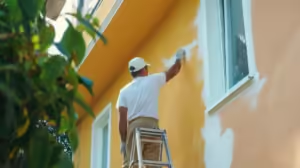Introduction to Weather-Resistant Paints
Weather-resistant paints are specially formulated coatings designed to protect surfaces from the harsh effects of environmental elements, including rain, humidity, wind, and sunlight. These paints serve as a shield that not only enhances the appearance of various structures but also significantly prolongs their lifespan. The importance of weather-resistant paints cannot be overstated, as they play a crucial role in preventing damage caused by weather conditions that can lead to deterioration, mold growth, and structural issues.
In residential settings, weather-resistant paints are commonly used on exterior walls, fences, decks, and furniture. These applications help to maintain aesthetics while offering defense against moisture intrusion and UV rays, which can fade and degrade surface materials over time. Commercial properties also greatly benefit from the use of weather-resistant coatings. From storefronts to warehouses, these paints ensure that a business’s exterior remains appealing and intact, reinforcing the overall image of professionalism and care.
In the industrial sector, weather-resistant paints are vital for machinery, storage tanks, and buildings exposed to harsh weather conditions. The resilience these coatings provide is essential for maintaining operational efficiency and safety. Moreover, industries such as marine and automotive rely heavily on specialized weather-resistant finishes to protect vessels and vehicles from extreme weather fluctuations, saltwater exposure, and corrosive chemicals.
As we delve deeper into the world of weather-resistant paints, it becomes evident that these coatings are more than just aesthetics; they embody a blend of functionality and durability designed to safeguard surfaces across various applications. Understanding the characteristics and benefits of these paints is essential for selecting the right product tailored to specific environmental conditions.

Types of Weather-Resistant Paint
Weather-resistant paints are essential for ensuring the longevity and durability of surfaces exposed to the elements. Various types of weather-resistant paints are available on the market, each designed for specific applications and conditions. Understanding these options can help you make informed decisions for your projects.
Acrylic paints are widely used for their excellent adhesion and flexibility. They are water-based and allow for easy cleanup, making them a favorite among DIY enthusiasts. Acrylic paints quickly dry and form a protective barrier against moisture, UV rays, and other environmental factors. However, they may not adhere well to certain surfaces without proper preparation.
Latex paints, similar to acrylic, are another popular choice for exterior applications. They offer low VOC levels and are resistant to mildew and fading, enhancing their appeal for environmentally-conscious consumers. While latex paint is easy to apply and dries quickly, its durability can vary depending on the formulation, so it is essential to choose a high-quality product for weather resistance.
Oil-based paints have traditionally been favored for their rich finish and strong adhesion properties. They provide excellent waterproofing capabilities and are particularly effective for surfaces that undergo heavy wear and tear. However, oil-based paints take longer to dry and require solvents for cleanup, which can pose environmental concerns.
Elastomeric paints are specialized weather-resistant coatings designed for applications on masonry and concrete surfaces. These paints possess extraordinary elasticity and can bridge small cracks, effectively preventing water intrusion. While they offer superior protection, elastomeric paints can be more expensive and require careful application to achieve optimal results.
By comprehensively understanding the various types of weather-resistant paints—including their advantages and disadvantages—you can select the best product to protect your surfaces effectively. Each type has its unique characteristics tailored to specific environments, ensuring your surfaces remain protected for years to come.
Key Features of Weather-Resistant Paints
Weather-resistant paints are specifically designed to endure the diverse challenges posed by environmental factors. One of the most critical characteristics of these paints is their UV resistance. Ultraviolet rays from the sun can cause fading and degradation of conventional paints, leading to compromised aesthetics and protective qualities. Weather-resistant paints include UV-blocking additives that help maintain color integrity and prevent peeling, thus significantly extending the lifespan of painted surfaces.
Another essential feature is water repellency. This property ensures that the paint does not absorb moisture, which can lead to issues such as blistering, mold growth, and structural damage. Weather-resistant paints achieve this through specialized formulations that create a barrier, repelling rain and moisture. This is particularly important in regions with high humidity and frequent rainfall, where traditional paints may falter.
Mildew resistance is another vital characteristic of weather-resistant coatings. Paints formulated to resist mildew inhibit the growth of mold and mildew on surfaces. This quality not only keeps the surfaces clean and visually appealing but also contributes to healthier indoor and outdoor environments. Especially in damp climates, mildew resistance is an indispensable feature to consider when selecting paint.
Finally, the durability of weather-resistant paints cannot be understated. These paints are engineered to withstand extreme temperatures, high winds, and varying moisture levels. Their robust formulation provides superior adhesion and flexibility, reducing the likelihood of cracking and flaking. This durability ensures that painted surfaces remain intact and visually appealing over extended periods, minimizing the need for frequent maintenance or repainting.
By understanding these key features—UV resistance, water repellency, mildew resistance, and durability—consumers can make informed decisions about the best weather-resistant paints for their specific needs, ensuring long-lasting protection for their surfaces under various environmental conditions.

Preparing Surfaces for Weather-Resistant Painting
Proper surface preparation is crucial for achieving optimal results when applying weather-resistant paints. The first step in this process is thorough cleaning of the surfaces to be painted. This involves removing any dirt, grime, mildew, or previous layers of paint that may interfere with adhesion. Depending on the surface, pressure washing may be an effective method for addressing stubborn materials, while soap and water can suffice for less contaminated areas. Ensuring a clean surface will facilitate the bonding of the new paint, enhancing its durability and overall resistance to environmental factors.
After the cleaning process, it is essential to inspect the surface for any damages that need repair. Cracks, holes, and peeling paint should be addressed prior to application. Use appropriate fillers or patching compounds for this purpose, allowing sufficient time for the repairs to set before continuing. The importance of this step cannot be overstated, as neglecting to repair damaged surfaces can lead to failure in the paint’s protective features, ultimately shortening its lifespan.
Priming the surface is another fundamental step in preparation. A high-quality primer suited for weather-resistant paints not only enhances adhesion but also ensures an even finish, improving the final appearance. Primers act as a barrier against moisture, which is particularly important in weather-prone areas. Choose a primer compatible with both the surface material and the specific paint being applied. When selecting tools, it is advisable to use high-quality brushes, rollers, or spray equipment to achieve a smooth application, further contributing to the longevity of the paint job.
Following these steps will ensure that your surfaces are well-prepared for the application of weather-resistant paints, leading to improved adhesion and performance over time.
Applying Weather-Resistant Paint: Techniques and Tips
Applying weather-resistant paint effectively is essential for ensuring long-lasting protection against the elements. Selecting the right conditions is the first step in achieving an optimal finish. It is advisable to paint on dry, mild days, with temperatures ranging between 50°F and 85°F (10°C and 29°C). Avoid painting during extreme weather, particularly when there are high winds or humidity, as these factors can adversely affect the application process and the paint’s final appearance.
When it comes to tools and brushes, the choice of paint application method significantly impacts the result. Professional painters often recommend using high-quality brushes or rollers that are appropriate for the paint type, whether it be latex or oil-based. For larger areas, a sprayer can provide an even coat more efficiently, although it may require more preparation and cleanup time. Ensure that you have a mix of tools depending on the surfaces you are working on, as intricate areas may benefit from fine brushes while flat surfaces can be covered with rollers or spray equipment.
Utilizing the proper application techniques is crucial. Begin by evenly priming the surface to create a solid foundation. When rolling or brushing paint onto the surface, use long, even strokes while working in sections to maintain control and consistency. Apply the paint in thin layers, allowing adequate drying time between coats; this prevents issues such as bubbling or peeling. Be cautious of overloading your brush or roller, as excess paint can lead to drips or an uneven finish.
Finally, observe best practices during the application process. Work from the top down and maintain a wet edge to blend each stroke seamlessly. If you encounter imperfections, such as runs or uneven spots, remedy them promptly by lightly sanding and recoating. By adhering to these techniques and tips, you can achieve an even, professional-looking finish with your weather-resistant paint, extending the life of your surfaces against outdoor conditions.

Caring for Weather-Resistant Painted Surfaces
Maintaining weather-resistant painted surfaces is essential for ensuring their longevity and effectiveness in protecting the substrate beneath. Just as any other surface requires regular attention, weather-resistant paints benefit greatly from a consistent care routine. This routine typically includes regular cleaning, inspections for any signs of damage, and touch-up procedures to keep surfaces in optimal condition.
Cleaning is the first step in caring for weather-resistant surfaces. It is advisable to implement a regimen of gentle cleaning every six months, using a mixture of mild soap and water. A soft cloth or sponge can effectively remove dirt and grime without compromising the paint’s integrity. High-pressure washing is generally not recommended, as it may strip the paint or cause it to become detached from the surface.
Additionally, routine inspections are crucial for identifying any potential issues before they escalate. During these checks, look for peeling, fading, or cracking. Such damage can compromise the protective qualities of the paint. If any areas show signs of deterioration, it’s essential to address them promptly.
For minor touch-ups, the process is relatively straightforward. First, clean the affected area, allowing it to dry completely. Then, apply weather-resistant paint that matches the original color. For larger repairs, you may need to reapply the paint over a larger area to ensure an even finish and maintain the protective barrier.
In conclusion, caring for weather-resistant painted surfaces involves regular cleaning, inspections, and timely repairs. By adhering to these practices, homeowners can extend the life of their weather-resistant paint and maintain the aesthetic appeal of their surfaces, ensuring they continue to perform effectively against the elements.
Common Mistakes to Avoid When Using Weather-Resistant Paint
When applying weather-resistant paint, both DIY enthusiasts and professionals often encounter several common mistakes that can compromise the effectiveness of the product. One of the most prevalent issues is inadequate surface preparation. Many individuals underestimate the importance of thoroughly cleaning and priming the surface before painting. Dirt, dust, and moisture can severely affect the adhesion and performance of the paint, leading to premature peeling and failure. It is essential to ensure that the surface is completely dry and free from contaminants. A well-prepared surface is fundamental for achieving optimal results.
Another misconception is disregarding environmental factors during the application process. Weather conditions can significantly influence the paint’s curing and drying times. For instance, applying paint during high humidity or extreme temperatures can lead to improper curing, resulting in a subpar finish. It is advisable to check weather forecasts and choose a day with mild, dry conditions for application. Additionally, it is important to follow the manufacturer’s specific guidelines regarding temperature and moisture levels to ensure the paint performs as intended.
Using incompatible products is yet another mistake that can be easily avoided. Many DIYers may mix different brands or types of paint without understanding their chemical compositions. This can lead to issues such as poor adhesion and blemished finishes. Using a primer that is compatible with the weather-resistant paint is crucial to set the base for a durable topcoat. To avoid these issues, always read product labels and consult technical data sheets to ensure compatibility between materials.
Lastly, neglecting maintenance after application can minimize the lifespan of weather-resistant paint. Regular inspections and touch-ups can help identify any issues early, keeping surfaces protected and visually appealing. By avoiding these common pitfalls, individuals can ensure a successful application and achieve the full benefits of weather-resistant paints.
Cost Analysis: Weather-Resistant Paint vs. Regular Paint
The financial considerations when choosing between weather-resistant paint and traditional paint can significantly influence a project’s overall budget. Initially, the upfront cost of weather-resistant paint is often higher than that of regular paint. For example, while traditional exterior paint may cost around $20 to $50 per gallon, high-quality weather-resistant formulations may range from $30 to $80 per gallon. This price discrepancy reflects the advanced ingredients and technology used in creating paints designed to endure extreme weather conditions.
However, it is essential to view these costs in a broader context, considering the long-term savings associated with durability and maintenance. Weather-resistant paints tend to have superior endurance against elements such as UV rays, moisture, and temperature fluctuations. This resilience results in a longer lifespan and reduces the frequency of repainting. Regular paint may require repainting every three to five years, whereas weather-resistant options can last eight to ten years or more. Therefore, although the initial investment is greater, weather-resistant paints can ultimately prove more economical over time.
Further supporting their value, these specialized paints often come with warranties that extend significantly longer than those for standard paints, providing additional assurance of their performance. This added protection can be particularly beneficial in regions prone to severe weather changes. Overall, while the initial price of weather-resistant paint is a factor to consider, the potential for reduced maintenance costs and the value added through enhanced durability make it a financially sound choice for many projects.
Final Thoughts on Weather-Resistant Paints
As we conclude our exploration of weather-resistant paints, it is essential to highlight the crucial benefits that these specialized coatings offer. These paints are designed to withstand the rigors of various environmental conditions, including moisture, UV rays, and temperature fluctuations. By opting for quality weather-resistant paints, homeowners and property managers not only ensure the longevity and aesthetic appeal of their surfaces but also protect their investments from the damaging effects of the elements.
When making a decision about which weather-resistant paint to use, it is important to consider the specific needs of your surfaces. This includes assessing the type of material, the surrounding environment, and any potential challenges such as high humidity or extreme sun exposure. For instance, surfaces exposed to high moisture levels may benefit from paints with added mildew resistance, while areas under direct sunlight might require UV-resistant formulations. Understanding these factors will lead to more informed decisions, resulting in a finish that lasts and maintains its visual appeal over time.
Furthermore, the aesthetic considerations should not be overlooked. High-quality weather-resistant paints come in a vast range of colors and finishes, allowing individuals to express their style while ensuring their surfaces remain protected. Therefore, while the practical advantages of these coatings are paramount, they do not compromise on aesthetic quality.
Ultimately, investing in weather-resistant paints is a proactive approach to safeguarding your property against harsh conditions. By selecting the right products thoughtfully and considering the unique circumstances of your environment, you can achieve a durable, visually pleasing finish that stands the test of time. The right choice leads to lasting results, making it imperative to prioritize both protection and aesthetics in your painting projects.


